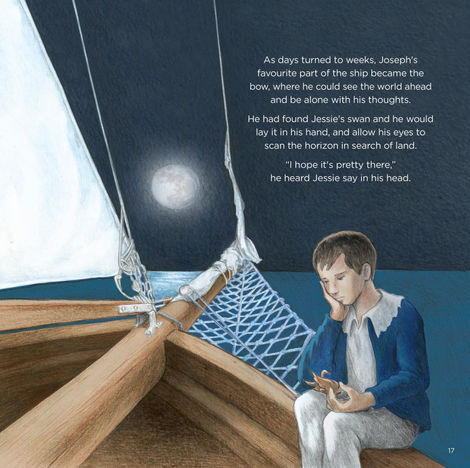
I Hope It's Pretty There

In 1829, a ship set sail for a new colony in Western Australia.
Two of its passengers never got there.
In February 1829, a ship called Parmelia left England and headed for the west coast of Australia. It was packed with men, women and children set on building a new life for themselves by the mouth of the Swan River. Among them was young Joseph Daly, his mum, dad and four siblings. Filled with hope, uncertainty — and cases full of pots, pans and other household goods — the passengers were to become the first European settlers to the new colony. But the promise of a new idyllic life is shattered when tragedy strikes during the voyage.
I Hope It’s Pretty There recounts the drama of the historic journey through Joseph’s eyes and serves as a bittersweet tale of hope, courage, loss and resilience.
Take a peek inside
Pages from I Hope It's Pretty There, illustrated by Kevin Vindeg.

For the classroom
An extensive teaching and learning kit can be downloaded from the WA Museum website.



How come this story?
A few years ago, while working as an Education Officer at the Western Australian Museum, I was developing a school program about WA’s early colonial history.
Among the pile of reference materials that littered my desk was a passenger list from the Parmelia, the ship that brought the first European families to the Swan River Colony. A thing that struck me about that list was how many kids were on board – about a third of all passengers! I also noticed small crosses next to two of the names. It turned out that these represented a couple of people who drowned along the way: the man who was to be the assistant surgeon to the Colony, Tully Daly, and his young daughter, Jessie.
I came across that list in the middle of winter. The day was cold, wet and windy – just like it had been when the Parmelia arrived to the WA coast. Around lunchtime, I was called away from my office at the Shipwreck Galleries to go to the Maritime Museum, which is a ten minute walk up the road in Fremantle’s west end. The path took me past Bathers Beach, and as I walked, huddled against the rain, I watched the surf crash against the seaweed-coated sand and I found myself thinking about the Daly family.
After Tully and Jessie died, the mum, Jane, and her four surviving children had no choice but to carry on to the Swan River. What would it have been like for this family, I kept asking myself, to step through the surf onto a beach like that, in weather like that? To grieve, so far from home? To enter, bewildered, into an inhospitable land that was – to them – completely unknown?
An image of the family, knee deep in water, seared onto my mind. It wouldn’t dissolve till I wrote their story.



